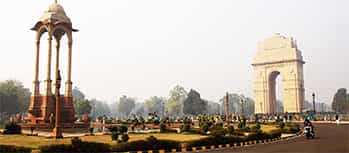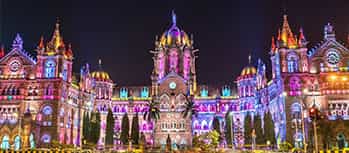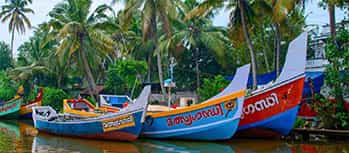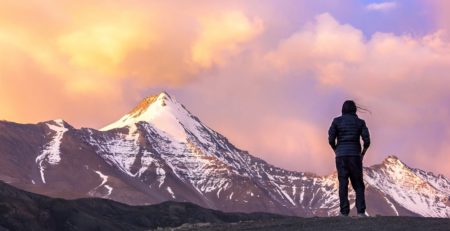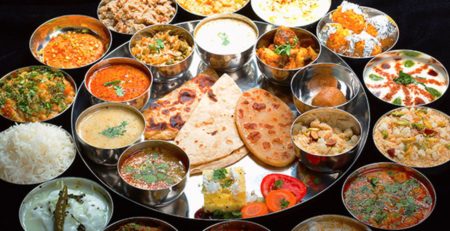Explore Destinations
What people are exploring in india.
Explore Culture & Tradition
 India has achieved all-round socio-economic progress during the last 70 years of its Independence. India has become self-sufficient in agricultural production and is now one of the top industrialised countries in the world and one of the few nations to have gone into outer space to conquer nature for the benefit of the people. It covers an area of 32,87,263 sq. km (1,269,346 sq mi), extending from the snow-covered Himalayan heights to the tropical rain forests of the south. As the 7th largest country in the world, India stands apart from the rest of Asia, marked off as it is by mountains and the sea, which give the country a distinct geographical entity. Bounded by the Great Himalayas in the north, it stretches southwards and at the Tropic of Cancer, tapers off into the Indian Ocean between the Bay of Bengal on the east and the Arabian Sea on the west.
India has achieved all-round socio-economic progress during the last 70 years of its Independence. India has become self-sufficient in agricultural production and is now one of the top industrialised countries in the world and one of the few nations to have gone into outer space to conquer nature for the benefit of the people. It covers an area of 32,87,263 sq. km (1,269,346 sq mi), extending from the snow-covered Himalayan heights to the tropical rain forests of the south. As the 7th largest country in the world, India stands apart from the rest of Asia, marked off as it is by mountains and the sea, which give the country a distinct geographical entity. Bounded by the Great Himalayas in the north, it stretches southwards and at the Tropic of Cancer, tapers off into the Indian Ocean between the Bay of Bengal on the east and the Arabian Sea on the west.
Lying entirely in the northern hemisphere, the mainland extends between latitudes 8° 4′ and 37° 6′ north, longitudes 68° 7′ and 97° 25′ east and measures about 3,214 km from north to south between the extreme latitudes and about 2,933 km from east to west between the extreme longitudes. It has a land frontier of about 15,200 km. The total length of the coastline of the mainland, Lakshadweep Islands and Andaman & Nicobar Islands is 7,516.6 km.
India, also known as Bharat, is a Union of States. It is a Sovereign Socialist Secular Democratic Republic with a parliamentary system of government. The Republic is governed in terms of the Constitution of India which was adopted by the Constituent Assembly on 26th November, 1949 and came into force on 26th January, 1950. The Constitution provides for a Parliamentary form of government which is federal in structure with certain unitary features. The constitutional head of the Executive of the Union is the President. As per Article 79 of the Constitution of India, the council of the Parliament of the Union consists of the President and two Houses known as the Council of States (Rajya Sabha) and the House of the People (Lok Sabha). Article 74(1) of the Constitution provides that there shall be a Council of Ministers with the Prime Minister as its head to aid and advise the President, who shall exercise his/her functions in accordance to the advice. The real executive power is thus vested in the Council of Ministers with the Prime Minister as its head.
| Particulars | Description |
|---|---|
| Country Name | Republic of India; Bharat Ganrajya |
| Government Type | Sovereign Socialist Secular Democratic Republic with a Parliamentary system of Government. |
| Capital | New Delhi |
| Administrative Divisions | 29 States and 7 Union Territories. |
| Independence | 15th August 1947 (From the British Colonial Rule) |
| Constitution | The Constitution of India came into force on 26th January 1950. |
| Legal System | The Constitution of India is the fountain source of the legal system in the Country. |
| Executive Branch | The President of India is the Head of the State, while the Prime Minister is the Head of the Government, and runs office with the support of the Council of Ministers who form the Cabinet Ministry. |
| Legislative Branch | The Indian Legislature comprises of the Lok Sabha (House of the People) and the Rajya Sabha (Council of States) forming both the Houses of the Parliament. |
| Judicial Branch | The Supreme Court of India is the apex body of the Indian legal system, followed by other High Courts and subordinate Courts. |
| Flag Description | The National Flag is a horizontal tricolour of deep saffron (kesaria) at the top, white in the middle, and dark green at the bottom in equal proportion. At the centre of the white band is a navy blue wheel, which is a representation of the Ashoka Chakra at Sarnath. |
| National Days | 26th January (Republic Day) 15th August (Independence Day) 2nd October (Gandhi Jayanti; Mahatma Gandhi’s Birthday) |
| Particulars | Description |
|---|---|
| Location | The Indian peninsula is separated from mainland Asia by the Himalayas. The Country is surrounded by the Bay of Bengal in the east, the Arabian Sea in the west, and the Indian Ocean to the south. |
| Geographic Coordinates | Lying entirely in the Northern Hemisphere, the Country extends between 8° 4′ and 37° 6′ latitudes north of the Equator, and 68° 7′ and 97° 25′ longitudes east of it. |
| Indian Standard Time | GMT + 05:30 |
| Area | 3.3 Million sq. km |
| Telephone Country Code | +91 |
| Border Countries | Afghanistan and Pakistan to the north-west; China, Bhutan and Nepal to the north; Myanmar to the east; and Bangladesh to the east of West Bengal. Sri Lanka is separated from India by a narrow channel of sea, formed by Palk Strait and the Gulf of Mannar. |
| Coastline | 7,517 km encompassing the mainland, Lakshadweep Islands, and the Andaman & Nicobar Islands. |
| Climate | The climate of India can broadly be classified as a tropical monsoon one. But, in spite of much of the northern part of India lying beyond the tropical zone, the entire country has a tropical climate marked by relatively high temperatures and dry winters. There are four seasons:
|
| Terrain | The mainland comprises of four regions, namely the great mountain zone, plains of the Ganga and the Indus, the desert region, and the southern peninsula. |
| Natural Resources | Coal, iron ore, manganese ore, mica, bauxite, petroleum, titanium ore, chromite, natural gas, magnesite, limestone, arable land, dolomite, barytes, kaolin, gypsum, apatite, phosphorite, steatite, fluorite, etc. |
| Natural Hazards | Monsoon floods, flash floods, earthquakes, droughts, and landslides. |
| Environment – Current Issues | Air pollution control, energy conservation, solid waste management, oil and gas conservation, forest conservation, etc. |
| Environment – International Agreements | Rio Declaration on environment and development, Cartagena Protocol on biosafety, Kyoto Protocol to the United Nations Framework Convention on climatic change, World Trade Agreement, Helsinki Protocol to LRTAP on the reduction of sulphur emissions of nitrogen oxides or their transboundary fluxes (Nox Protocol), and Geneva Protocol to LRTAP concerning the control of emissions of volatile organic compounds or their transboundary fluxes (VOCs Protocol). |
| Geography – Note | India occupies a major portion of the south Asian subcontinent. |
| Download various maps of India | Physical, Political, Population, Rain fall, Railway & Sea Routes, Road, Soil, etc. |
| Particulars | Description |
|---|---|
| Population | India’s population, as on 1 March 2011 stood at 1,210,193,422 (623.7 million males and 586.4 million females). |
| Population Growth Rate | The average annual exponential growth rate stands at 1.64 per cent during 2001-2011. |
| Birth Rate | The Crude Birth rate was 18.3 in 2009. |
| Death Rate | The Crude Death rate was 7.3 in 2009. |
| Life Expectancy Rate | 65.8 years (Males); 68.1 years (Females) in the period 2006-2011. |
| Sex Ratio | 940 females per 1000 males according to 2011 census |
| Nationality | Indian |
| Ethnic Groups | All the five major racial types – Australoid, Mongoloid, Europoid, Caucasian, and Negroid find representation among the people of India. |
| Religions | According to the 2001 census, out of the total population of 1,028 million in the Country, Hindus constituted the majority with 80.5%, Muslims came second at 13.4%, followed by Christians, Sikhs, Buddhists, Jains, and others. |
| Languages | There are 22 different languages that have been recognised by the Constitution of India, of which Hindi is an Official Language. Article 343(3) empowered Parliament to provide by law for continued use of English for official purposes. |
| Literacy | According to the provisional results of the 2011 census, the literacy rate in the Country stands at 74.04 per cent, 82.14% for males and 65.46% for females. |
Although India possesses a wide range of minerals and other natural resources, its per capita endowment of such critical resources as cultivable land, water, timber, and known petroleum reserves is relatively low. Nevertheless, the diversity of resources, especially of minerals, exceeds that of all but a few countries and gives India a distinct advantage in its industrial development.
Domestically supplied minerals form an important underpinning for India’s diversified manufacturing industry, as well as a source of modest export revenues. Nationalizing many foreign and domestic enterprises and government initiation and management of others gave the Indian government a predominant role in the mining industry. However, government involvement has been gradually reduced as private investment has grown.
Among mineral resources, iron ore (generally of high quality) and ferroalloys—notably manganese and chromite—are particularly abundant, and all are widely distributed over peninsular India. Other exploitable metallic minerals include copper, bauxite (the principal ore of aluminum), zinc, lead, gold, and silver. Among important nonmetallic and nonfuel minerals are limestone, dolomite, rock phosphate, building stones, ceramic clays, mica, gypsum, fluorspar, magnesite, graphite, and diamonds.
Of the many metals produced, iron—mined principally in Madhya Pradesh, Bihar, Goa, Karnataka, and Orissa—ranks first in value. Copper, derived mainly from Rajasthan and Bihar, is a distant second. Gold, zinc and lead (often mined together), the ferroalloys (chiefly manganese and chromite), and bauxite also are important. Noteworthy nonmetallic minerals include limestone, dolomite, rock phosphate, gypsum, building stone, and ceramic clays.
In terms of the value of production, fuel minerals far exceed all others combined. Among the fuels, petroleum ranks first in value, followed by coal (including lignite). India produces only a portion of its petroleum needs but produces a slight exportable surplus of coal. Virtually all of India’s petroleum comes from the offshore Bombay High Field and from Gujarat and Assam, while coal comes from some 500 mines, both surface and deep-pit, distributed over a number of states. By far the most important coal-producing region is along the Damodar River, including the Jharia and Raniganj fields in Bihar and West Bengal, which account for about half the nation’s output and virtually all the coal of coking quality. Natural gas is of little importance. Uranium is produced in modest quantities in Bihar.
Among the fossil fuels, India is well endowed with coal and modestly so with lignite. Coal supplies are widespread but are especially abundant and easy to mine in the Chota Nagpur Plateau, which is the principal source area for coking coal. Domestic reserves of petroleum and natural gas, though abundant, do not meet the country’s large demand. Petroleum fields are located in eastern Assam (India’s oldest production region) and in Gujarat and offshore in the Arabian Sea on an undersea structure known as the Bombay High. Several other onshore and offshore petroleum reserves have been discovered, including sites in Tamil Nadu, Andhra Pradesh, and Arunachal Pradesh.
The country’s utilities, overwhelmingly in government hands, are barely able to keep pace with the rapidly rising demand for various types of service. Electricity consumption, for example, increased 16-fold between 1951 and 1980 and more than quadrupled again in the next quarter century. The bulk of all electricity generated is from widely dispersed coal-powered thermal plants; most of the remainder is from hydroelectric plants, built mainly in mountainous regions or along major escarpments; and only a tiny amount comes from a few nuclear installations. Power outages and rationing are frequently necessary in periods of peak demand, since growing demand often outstrips installed capacity in many locales. More than half of all electricity is industrially used. Agricultural use, largely for raising irrigation water from deep wells, exceeds domestic consumption. Rural electrification is increasing rapidly, and the great bulk of all villages are now tied into some distribution grid.
The Indian economy has survived the global downturn very well. It has posted one of the highest rates of economic growth in the world despite other major industrial giants lagging behind. At the end of 2009, the Indian economy was growing at 7% a year. The strongest growth was coming from the manufacturing and construction sector and the weakest section was agriculture. The strong rate of economic growth boosts prospects for the Indian Rupee in the years to come. The drawback of such a rapid economic expansion is a rise in inflation.The economy of India is the eleventh largest economy in the world by nominal GDP. Post independence the country went into a fast paced economic growth which was further fuelled by the free market principles started in the 1990’s which welcomed foreign investments. It has been predicted by leading Economists around the world that by 2020, India will be among the leading economies of the world.
Four key industrial economic sectors are identified in India. The primary sector, largely extract raw material and they are mining and farming industries. In the secondary sector, refining, construction, and manufacturing are included. The tertiary sector deals with services and distribution of manufactured goods. India’s service industry accounts for 57.2% of the country’s GDP while the industrial and agricultural sector contribute 28% and 14.6% respectively. Agriculture is the predominant occupation in India, accounting for about 52% of direct and indirect employment. The service sector makes up a further 34%, and industrial sector around 14%. The labour force totals around half a billion workers. Industry accounts for 28% of the GDP and employ 14% of the total workforce.
Economic reforms brought foreign competition in the industrial scenario, led to privatization of certain public sector industries, opened up sectors hitherto reserved for the public sector and led to an expansion in the production of fast-moving consumer goods. Textile industry is the second largest source for employment after agriculture and accounts for 26% of manufacturing output.Information technology is one among the fastest growing sector contributing to one third of the total output of services. The growth in the IT sector is attributed to increased specialization, and an availability of a large pool of low cost, highly skilled, educated and fluent English-speaking workers around the country. Cities like Bangalore, Hyderabad and Pune have established themselves as major IT hubs in the country.
The Indian environment is suffering a great deal due to this industrialization. Pollution, deforestation, and the destruction of flora and fauna continue to skyrocket. But industrialization did have good outcomes. Material well-being and improved health care came to our doorsteps. New goods, new choices and new comforts came about. It also led the way for other ideas such as women’s rights, human rights, right to information and child labor laws, etc. Simply stated, industrialization did have its good aspects as well as its bad on India. But indeed the Industrial Revolution was a huge achievement.
 India is the 17th largest export economy in the world. In 2016, India exported $261B and imported $339B, resulting in a negative trade balance of $78B. In 2016 the GDP of India was $2.26T and its GDP per capita was $6.57k.
India is the 17th largest export economy in the world. In 2016, India exported $261B and imported $339B, resulting in a negative trade balance of $78B. In 2016 the GDP of India was $2.26T and its GDP per capita was $6.57k.
The top exports of India are Diamonds ($29.4B), Refined Petroleum ($22.8B), Packaged Medicaments ($14.6B), Jewellery ($8.48B) and Cars ($5.99B), using the 1992 revision of the HS (Harmonized System) classification. Its top imports are Crude Petroleum ($54.8B), Gold ($22.9B), Diamonds ($19.9B), Coal Briquettes ($12.3B) and Telephones ($10.1B).
The top export destinations of India are the United States ($45.5B), the United Arab Emirates ($15.5B), Hong Kong ($15.5B), China ($10.7B) and the United Kingdom ($8.66B). The top import origins are China ($58.9B), the United States ($19.9B), the United Arab Emirates ($18.4B), Saudi Arabia ($17.2B) and Switzerland ($14.8B).
India borders Afghanistan, Bangladesh, Bhutan, China, Burma, Nepal and Pakistan by land and Indonesia, Sri Lanka, Maldives and Thailand by sea.
- + Country Profile
-
 India has achieved all-round socio-economic progress during the last 70 years of its Independence. India has become self-sufficient in agricultural production and is now one of the top industrialised countries in the world and one of the few nations to have gone into outer space to conquer nature for the benefit of the people. It covers an area of 32,87,263 sq. km (1,269,346 sq mi), extending from the snow-covered Himalayan heights to the tropical rain forests of the south. As the 7th largest country in the world, India stands apart from the rest of Asia, marked off as it is by mountains and the sea, which give the country a distinct geographical entity. Bounded by the Great Himalayas in the north, it stretches southwards and at the Tropic of Cancer, tapers off into the Indian Ocean between the Bay of Bengal on the east and the Arabian Sea on the west.
India has achieved all-round socio-economic progress during the last 70 years of its Independence. India has become self-sufficient in agricultural production and is now one of the top industrialised countries in the world and one of the few nations to have gone into outer space to conquer nature for the benefit of the people. It covers an area of 32,87,263 sq. km (1,269,346 sq mi), extending from the snow-covered Himalayan heights to the tropical rain forests of the south. As the 7th largest country in the world, India stands apart from the rest of Asia, marked off as it is by mountains and the sea, which give the country a distinct geographical entity. Bounded by the Great Himalayas in the north, it stretches southwards and at the Tropic of Cancer, tapers off into the Indian Ocean between the Bay of Bengal on the east and the Arabian Sea on the west.Lying entirely in the northern hemisphere, the mainland extends between latitudes 8° 4′ and 37° 6′ north, longitudes 68° 7′ and 97° 25′ east and measures about 3,214 km from north to south between the extreme latitudes and about 2,933 km from east to west between the extreme longitudes. It has a land frontier of about 15,200 km. The total length of the coastline of the mainland, Lakshadweep Islands and Andaman & Nicobar Islands is 7,516.6 km.
- + Government
-
India, also known as Bharat, is a Union of States. It is a Sovereign Socialist Secular Democratic Republic with a parliamentary system of government. The Republic is governed in terms of the Constitution of India which was adopted by the Constituent Assembly on 26th November, 1949 and came into force on 26th January, 1950. The Constitution provides for a Parliamentary form of government which is federal in structure with certain unitary features. The constitutional head of the Executive of the Union is the President. As per Article 79 of the Constitution of India, the council of the Parliament of the Union consists of the President and two Houses known as the Council of States (Rajya Sabha) and the House of the People (Lok Sabha). Article 74(1) of the Constitution provides that there shall be a Council of Ministers with the Prime Minister as its head to aid and advise the President, who shall exercise his/her functions in accordance to the advice. The real executive power is thus vested in the Council of Ministers with the Prime Minister as its head.
Particulars Description Country Name Republic of India; Bharat Ganrajya Government Type Sovereign Socialist Secular Democratic Republic with a Parliamentary system of Government. Capital New Delhi Administrative Divisions 29 States and 7 Union Territories. Independence 15th August 1947 (From the British Colonial Rule) Constitution The Constitution of India came into force on 26th January 1950. Legal System The Constitution of India is the fountain source of the legal system in the Country. Executive Branch The President of India is the Head of the State, while the Prime Minister is the Head of the Government, and runs office with the support of the Council of Ministers who form the Cabinet Ministry. Legislative Branch The Indian Legislature comprises of the Lok Sabha (House of the People) and the Rajya Sabha (Council of States) forming both the Houses of the Parliament. Judicial Branch The Supreme Court of India is the apex body of the Indian legal system, followed by other High Courts and subordinate Courts. Flag Description The National Flag is a horizontal tricolour of deep saffron (kesaria) at the top, white in the middle, and dark green at the bottom in equal proportion. At the centre of the white band is a navy blue wheel, which is a representation of the Ashoka Chakra at Sarnath. National Days 26th January (Republic Day)
15th August (Independence Day)
2nd October (Gandhi Jayanti; Mahatma Gandhi’s Birthday) - + Geography
-
Particulars Description Location The Indian peninsula is separated from mainland Asia by the Himalayas. The Country is surrounded by the Bay of Bengal in the east, the Arabian Sea in the west, and the Indian Ocean to the south. Geographic Coordinates Lying entirely in the Northern Hemisphere, the Country extends between 8° 4′ and 37° 6′ latitudes north of the Equator, and 68° 7′ and 97° 25′ longitudes east of it. Indian Standard Time GMT + 05:30 Area 3.3 Million sq. km Telephone Country Code +91 Border Countries Afghanistan and Pakistan to the north-west; China, Bhutan and Nepal to the north; Myanmar to the east; and Bangladesh to the east of West Bengal. Sri Lanka is separated from India by a narrow channel of sea, formed by Palk Strait and the Gulf of Mannar. Coastline 7,517 km encompassing the mainland, Lakshadweep Islands, and the Andaman & Nicobar Islands. Climate The climate of India can broadly be classified as a tropical monsoon one. But, in spite of much of the northern part of India lying beyond the tropical zone, the entire country has a tropical climate marked by relatively high temperatures and dry winters. There are four seasons: - winter (December-February)
- summer (March-June)
- south-west monsoon season (June-September)
- post monsoon season (October-November)
Terrain The mainland comprises of four regions, namely the great mountain zone, plains of the Ganga and the Indus, the desert region, and the southern peninsula. Natural Resources Coal, iron ore, manganese ore, mica, bauxite, petroleum, titanium ore, chromite, natural gas, magnesite, limestone, arable land, dolomite, barytes, kaolin, gypsum, apatite, phosphorite, steatite, fluorite, etc. Natural Hazards Monsoon floods, flash floods, earthquakes, droughts, and landslides. Environment – Current Issues Air pollution control, energy conservation, solid waste management, oil and gas conservation, forest conservation, etc. Environment – International Agreements Rio Declaration on environment and development, Cartagena Protocol on biosafety, Kyoto Protocol to the United Nations Framework Convention on climatic change, World Trade Agreement, Helsinki Protocol to LRTAP on the reduction of sulphur emissions of nitrogen oxides or their transboundary fluxes (Nox Protocol), and Geneva Protocol to LRTAP concerning the control of emissions of volatile organic compounds or their transboundary fluxes (VOCs Protocol). Geography – Note India occupies a major portion of the south Asian subcontinent. Download various maps of India Physical, Political, Population, Rain fall, Railway & Sea Routes, Road, Soil, etc. - + Religion
-
Particulars Description Population India’s population, as on 1 March 2011 stood at 1,210,193,422 (623.7 million males and 586.4 million females). Population Growth Rate The average annual exponential growth rate stands at 1.64 per cent during 2001-2011. Birth Rate The Crude Birth rate was 18.3 in 2009. Death Rate The Crude Death rate was 7.3 in 2009. Life Expectancy Rate 65.8 years (Males); 68.1 years (Females) in the period 2006-2011. Sex Ratio 940 females per 1000 males according to 2011 census Nationality Indian Ethnic Groups All the five major racial types – Australoid, Mongoloid, Europoid, Caucasian, and Negroid find representation among the people of India. Religions According to the 2001 census, out of the total population of 1,028 million in the Country, Hindus constituted the majority with 80.5%, Muslims came second at 13.4%, followed by Christians, Sikhs, Buddhists, Jains, and others. Languages There are 22 different languages that have been recognised by the Constitution of India, of which Hindi is an Official Language. Article 343(3) empowered Parliament to provide by law for continued use of English for official purposes. Literacy According to the provisional results of the 2011 census, the literacy rate in the Country stands at 74.04 per cent, 82.14% for males and 65.46% for females. - + Natural Resources
-
Although India possesses a wide range of minerals and other natural resources, its per capita endowment of such critical resources as cultivable land, water, timber, and known petroleum reserves is relatively low. Nevertheless, the diversity of resources, especially of minerals, exceeds that of all but a few countries and gives India a distinct advantage in its industrial development.
Domestically supplied minerals form an important underpinning for India’s diversified manufacturing industry, as well as a source of modest export revenues. Nationalizing many foreign and domestic enterprises and government initiation and management of others gave the Indian government a predominant role in the mining industry. However, government involvement has been gradually reduced as private investment has grown.
Among mineral resources, iron ore (generally of high quality) and ferroalloys—notably manganese and chromite—are particularly abundant, and all are widely distributed over peninsular India. Other exploitable metallic minerals include copper, bauxite (the principal ore of aluminum), zinc, lead, gold, and silver. Among important nonmetallic and nonfuel minerals are limestone, dolomite, rock phosphate, building stones, ceramic clays, mica, gypsum, fluorspar, magnesite, graphite, and diamonds.
Of the many metals produced, iron—mined principally in Madhya Pradesh, Bihar, Goa, Karnataka, and Orissa—ranks first in value. Copper, derived mainly from Rajasthan and Bihar, is a distant second. Gold, zinc and lead (often mined together), the ferroalloys (chiefly manganese and chromite), and bauxite also are important. Noteworthy nonmetallic minerals include limestone, dolomite, rock phosphate, gypsum, building stone, and ceramic clays.
In terms of the value of production, fuel minerals far exceed all others combined. Among the fuels, petroleum ranks first in value, followed by coal (including lignite). India produces only a portion of its petroleum needs but produces a slight exportable surplus of coal. Virtually all of India’s petroleum comes from the offshore Bombay High Field and from Gujarat and Assam, while coal comes from some 500 mines, both surface and deep-pit, distributed over a number of states. By far the most important coal-producing region is along the Damodar River, including the Jharia and Raniganj fields in Bihar and West Bengal, which account for about half the nation’s output and virtually all the coal of coking quality. Natural gas is of little importance. Uranium is produced in modest quantities in Bihar.
Among the fossil fuels, India is well endowed with coal and modestly so with lignite. Coal supplies are widespread but are especially abundant and easy to mine in the Chota Nagpur Plateau, which is the principal source area for coking coal. Domestic reserves of petroleum and natural gas, though abundant, do not meet the country’s large demand. Petroleum fields are located in eastern Assam (India’s oldest production region) and in Gujarat and offshore in the Arabian Sea on an undersea structure known as the Bombay High. Several other onshore and offshore petroleum reserves have been discovered, including sites in Tamil Nadu, Andhra Pradesh, and Arunachal Pradesh.
The country’s utilities, overwhelmingly in government hands, are barely able to keep pace with the rapidly rising demand for various types of service. Electricity consumption, for example, increased 16-fold between 1951 and 1980 and more than quadrupled again in the next quarter century. The bulk of all electricity generated is from widely dispersed coal-powered thermal plants; most of the remainder is from hydroelectric plants, built mainly in mountainous regions or along major escarpments; and only a tiny amount comes from a few nuclear installations. Power outages and rationing are frequently necessary in periods of peak demand, since growing demand often outstrips installed capacity in many locales. More than half of all electricity is industrially used. Agricultural use, largely for raising irrigation water from deep wells, exceeds domestic consumption. Rural electrification is increasing rapidly, and the great bulk of all villages are now tied into some distribution grid.
- + Industries
-
The Indian economy has survived the global downturn very well. It has posted one of the highest rates of economic growth in the world despite other major industrial giants lagging behind. At the end of 2009, the Indian economy was growing at 7% a year. The strongest growth was coming from the manufacturing and construction sector and the weakest section was agriculture. The strong rate of economic growth boosts prospects for the Indian Rupee in the years to come. The drawback of such a rapid economic expansion is a rise in inflation.The economy of India is the eleventh largest economy in the world by nominal GDP. Post independence the country went into a fast paced economic growth which was further fuelled by the free market principles started in the 1990’s which welcomed foreign investments. It has been predicted by leading Economists around the world that by 2020, India will be among the leading economies of the world.
Four key industrial economic sectors are identified in India. The primary sector, largely extract raw material and they are mining and farming industries. In the secondary sector, refining, construction, and manufacturing are included. The tertiary sector deals with services and distribution of manufactured goods. India’s service industry accounts for 57.2% of the country’s GDP while the industrial and agricultural sector contribute 28% and 14.6% respectively. Agriculture is the predominant occupation in India, accounting for about 52% of direct and indirect employment. The service sector makes up a further 34%, and industrial sector around 14%. The labour force totals around half a billion workers. Industry accounts for 28% of the GDP and employ 14% of the total workforce.
Economic reforms brought foreign competition in the industrial scenario, led to privatization of certain public sector industries, opened up sectors hitherto reserved for the public sector and led to an expansion in the production of fast-moving consumer goods. Textile industry is the second largest source for employment after agriculture and accounts for 26% of manufacturing output.Information technology is one among the fastest growing sector contributing to one third of the total output of services. The growth in the IT sector is attributed to increased specialization, and an availability of a large pool of low cost, highly skilled, educated and fluent English-speaking workers around the country. Cities like Bangalore, Hyderabad and Pune have established themselves as major IT hubs in the country.
The Indian environment is suffering a great deal due to this industrialization. Pollution, deforestation, and the destruction of flora and fauna continue to skyrocket. But industrialization did have good outcomes. Material well-being and improved health care came to our doorsteps. New goods, new choices and new comforts came about. It also led the way for other ideas such as women’s rights, human rights, right to information and child labor laws, etc. Simply stated, industrialization did have its good aspects as well as its bad on India. But indeed the Industrial Revolution was a huge achievement.
- + Exports
-
 India is the 17th largest export economy in the world. In 2016, India exported $261B and imported $339B, resulting in a negative trade balance of $78B. In 2016 the GDP of India was $2.26T and its GDP per capita was $6.57k.
India is the 17th largest export economy in the world. In 2016, India exported $261B and imported $339B, resulting in a negative trade balance of $78B. In 2016 the GDP of India was $2.26T and its GDP per capita was $6.57k.The top exports of India are Diamonds ($29.4B), Refined Petroleum ($22.8B), Packaged Medicaments ($14.6B), Jewellery ($8.48B) and Cars ($5.99B), using the 1992 revision of the HS (Harmonized System) classification. Its top imports are Crude Petroleum ($54.8B), Gold ($22.9B), Diamonds ($19.9B), Coal Briquettes ($12.3B) and Telephones ($10.1B).
The top export destinations of India are the United States ($45.5B), the United Arab Emirates ($15.5B), Hong Kong ($15.5B), China ($10.7B) and the United Kingdom ($8.66B). The top import origins are China ($58.9B), the United States ($19.9B), the United Arab Emirates ($18.4B), Saudi Arabia ($17.2B) and Switzerland ($14.8B).
India borders Afghanistan, Bangladesh, Bhutan, China, Burma, Nepal and Pakistan by land and Indonesia, Sri Lanka, Maldives and Thailand by sea.


